PoongNamheon [Korea Quality] / 풍남헌 [한국관광 품질인증]
815.4397614363492m 8159 2024-04-07
35 , Eunhaeng-ro, Wansan-gu, Jeonju-si, Jeonbuk-do
+82-63-286-7673, +82-10-2757-7673
Pungnamheon is a hanok stay in a traditional nobleman's house in Jeonju, Jeollabuk-do. Next to the house stands a 600-year-old ginkgo tree, the guardian spirit of Jeonju Hanok Village. Two unusual features of this hanok is that there is no wood-floored hall or daecheong, and the toenmaru wooden porch is extra wide, and has a window. The floors are finished with laquered hanji (Korean paper), and the roof tiles were made in Goryeong. Old folding screens and Korean paintings complete the atmosphere of a traditional yangbang house. Guests have a chance to taste wild green tea gathered and made by the owner.
Seohak Art Village Library (서학예술마을도서관)
839.9050482720207m 0 2024-04-06
12-1 Seohak-ro, Wansan-gu, Jeonju-si, Jeonbuk-do
Seohak Art Village Library opened June 2022 in Jeonju, Jeollabuk-do. The library consists of nearly 1,000 books, making it rather small. However, the library makes up for its size with pretty decorations, making visitors want to stay longer. The library is located in an old building that was previously a cafe and gallery, so the library feels more like a book cafe.
Jeonju Kimchi Cultural Center (전주한옥마을 전주김치문화관)
845.331061387696m 29358 2024-04-07
29, Eojin-gil, Wansan-gu, Jeonju-si, Jeonbuk-do
+82-63-287-6300
Jeonju Kimchi Cultural Center is located in Jeonju, a UNESCO-designated City of Gastronomy. At the center, visitors can learn about the wisdom and science behind kimchi and Korean food culture.
Jeonju Hanok Village [Slow City] (전북 전주 한옥마을 [슬로시티])
850.0868366117843m 280674 2024-05-27
99 Girin-daero, Wansan-gu, Jeonju-si, Jeonbuk-do
+82-63-282-1330
Jeonju Hanok Village is comprised of some 700 beautiful hanok buildings, and is Korea's largest, and only urban, traditional hanok village. The village started in the early 1900s around the areas of Gyeonggijeon Shrine, Omokdae, and Jeonjuhyanggyo Confusian Academy - all important cultural heritages. To experience what hanok is like, visitors can either book a hanok accommodation or visit the Hanok Life Experience Hall.
Seonsam Jeonju Hyoja Store [Tax Refund Shop] (선삼전주효자판매점)
857.7544183513112m 0 2024-04-22
125, Geomapyeong-ro, Wansan-gu, Jeonju-si, Jeollabuk-do
-
Jeonju Cultural Heritage Night Tour (전주문화유산야행, 다 같이 전주마블!)
875.7686332654029m 11471 2024-04-18
44 Taejo-ro, Wansan-gu, Jeonju-si, Jeonbuk-do
+82-63-232-9937
Jeonju Cultural Heritage Night Tour focuses on preserving and remembering Korea’s heritages and the ancestors’ spirits. Jeonju features many historical sites from the Joseon dynasty and traditional culture.
Gyeonggijeon Shrine (경기전)
922.8392914841188m 55855 2024-05-27
44 Taejo-ro, Wansan-gu, Jeonju-si, Jeonbuk-do
+82-63-281-2790
A registered Historic Site, Gyeonggijeon Shrine was erected in 1410 and holds the portrait of King Tae-jo, the founder of the Joseon dynasty. The shrine was originally given the name Eoyongjeon, but was changed to its current name in 1442, the 24th year of King Sejong the Great. The structure was partially destroyed during the Imjin War (1592-1598), and was restored in 1614.
Jeonju Jeondong Catholic Cathedral (전주전동성당)
929.4986836316922m 52001 2024-05-27
51 Taejo-ro, Wansan-gu, Jeonju-si, Jeonbuk-do
Jeondong Catholic Cathedral in Jeonju was built in honor of Roman Catholic martyrs of the Joseon dynasty on the very same spot the martyrs lost their lives. The land was purchased by French Priest Baudenet in 1891 (28th year of King Gojong), but construction of the church did not begin until 1908. Construction was completed in 1914, a time during which Korea was under Japanese rule. Though originally built just outside of Pungnammun Gate, the site of the martyrs, the church was later moved to its current location for expansion.
The first Romanesque building in the Honam region, Jeondong Catholic Cathedral is made of gray and red bricks and bears a striking resemblance to the Myeongdong Cathedral in Seoul, also designed by Priest Poinel. Not only considered one of the most beautiful Catholic churches in Korea, some even go so far as to say it is one of the most beautiful structures in all of Korea, citing the church’s unique combination of Byzantine and Romanesque architectural styles. The rectangular building is topped with three Byzantine bell towers (to the right, center, and left) and boasts arched ceilings, several of which meet in the form of a cross.
It is interesting to note that some of the bricks used in construction of the church were made using materials from the Jeonjueupseong Walled Town, which was torn down by the Japanese. It is also said that the cornerstone of the church came from a wall of Jeonjueupseong Walled Town near Pungnammun Gate.
Song Song Gong Jak So - Jeonju Branch [Tax Refund Shop] (송송공작소 전주점)
931.9075210341998m 0 2024-04-22
21, Eunhaeng-ro, Wansan-gu, Jeonju-si, Jeollabuk-do
-
Ggol - Jeonju Branch [Tax Refund Shop] (꼴 전주점)
931.9075210341998m 0 2024-04-19
21, Eunhaeng-ro, Wansan-gu, Jeonju-si, Jeollabuk-do
-
![PoongNamheon [Korea Quality] / 풍남헌 [한국관광 품질인증]](http://tong.visitkorea.or.kr/cms/resource/73/3022073_image2_1.jpg)


![Jeonju Hanok Village [Slow City] (전북 전주 한옥마을 [슬로시티])](http://tong.visitkorea.or.kr/cms/resource/67/2654567_image2_1.jpg)




 English
English
 한국어
한국어 日本語
日本語 中文(简体)
中文(简体) Deutsch
Deutsch Français
Français Español
Español Русский
Русский